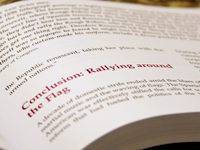Turning Points in American History
Florida Virtual School, the first and largest statewide Internet-based public high school in the United States, serves 64,000 students across Florida. It has been charged by the state legislature to give priority to minority and rural students and students in low-performing schools. Teachers will be recruited for Turning Points in American History (Turning Points) through an application process that incorporates a needs assessment as the main selection tool. Each year, participating teachers will engage in a 3-day, face-to-face National Council for History Education colloquium; online professional development and networking that includes readings, workshops, book discussions, and lesson development; and 3- to 5-day field study academies at historical sites and museums. All American history teachers in Florida Virtual School will have access to WebLessons, an online lesson development resource. A cohort of 30 teachers will receive services throughout all five years of the program. Project coordinators will identify a subgroup of 10 lead teachers who will provide ongoing professional development to all Florida Virtual School history teachers; six of these teachers will be eligible to attend a national history conference each year. Turning Points will explore watershed events that have changed American history—political and cultural revolutions, social and religious changes, new technologies, and explorations of unknown places. Teachers will learn to integrate primary documents, art, and thematic connections between literature and U.S. history into their instruction, as required by Florida’s new state social studies standards. Teacher-created lessons and enrichment activities such as podcasts and virtual field trips will be shared through the Florida Virtual School Web site.
